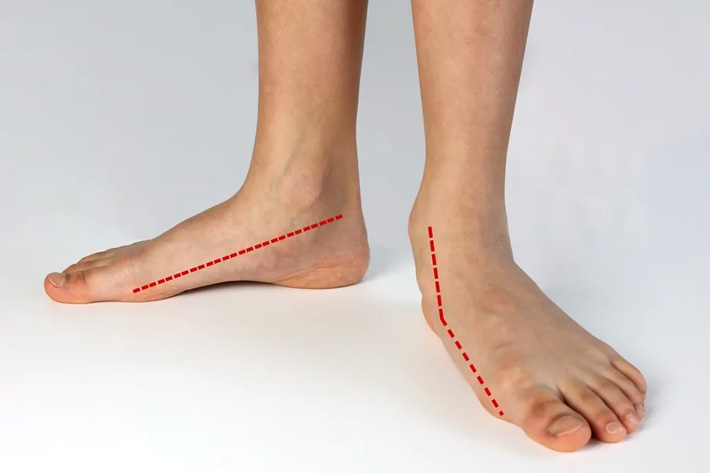Pes planus, also known as flat feet, is a condition characterized by a low or absent arch in the foot. While flat feet can be present from childhood, some individuals develop or experience worsening of the condition in adulthood. Adult pes planus can lead to various issues, including pain in the knee, hip, and back areas. This is primarily due to the altered axial alignment of the lower extremities.
The foot’s arch helps distribute the body’s weight evenly and absorb the shock generated during walking or running. In individuals with pes planus, the lack of a proper arch can cause the foot to roll inward excessively, known as overpronation. Overpronation can disrupt the normal alignment of the lower extremities, leading to the following effects:
- Knee pain: Overpronation causes the tibia (shinbone) and femur (thighbone) to rotate inward excessively, putting additional stress on the knee joint. This can lead to various knee problems, such as patellofemoral pain syndrome, medial meniscus tears, or iliotibial band syndrome.
- Hip pain: The misalignment of the lower limbs can also affect the hip joint. Overpronation can alter the hip’s biomechanics, causing increased stress and abnormal movement patterns. This can result in hip pain, bursitis, or even contribute to the development of conditions like hip osteoarthritis.
- Back pain: The misalignment originating from flat feet can extend beyond the lower extremities and affect the entire skeletal structure. The altered mechanics can cause an abnormal distribution of forces along the spine, leading to imbalances, muscle strain, and spinal abnormalities. This can result in pain in the lower back (lumbar region) or contribute to conditions like sciatica or lumbar spinal stenosis.
To address pain and discomfort associated with adult pes planus, various treatment options are available:
- Orthotic devices: Custom-made or over-the-counter shoe inserts, such as arch supports or orthotic insoles, can help provide better support, improve foot alignment, and alleviate pain.
- Physical therapy: Specific exercises and stretches can be recommended to strengthen the muscles and improve the alignment of the feet, knees, hips, and back. Physical therapy may also include modalities like ultrasound or electrical stimulation for pain relief.
- Footwear modifications: Wearing supportive shoes with good arch support and stability can help reduce overpronation and provide better alignment.
- Weight management: Maintaining a healthy weight can reduce the stress placed on your feet and help alleviate symptoms associated with flat feet.
- Pain management: Over-the-counter nonsteroidal anti-inflammatory drugs (NSAIDs), such as ibuprofen, can help alleviate pain and reduce inflammation. However, it is important to consult a healthcare professional before starting any medication.
- Surgical intervention: In severe cases of adult pes planus, where conservative measures fail to provide relief, surgical procedures may be considered. Surgical options aim to correct the alignment of the foot and restore its normal arch.
If you are experiencing pain or discomfort in the knee, hip, or back areas, it is recommended to consult with a healthcare professional, such as Dr Ananda who can evaluate your condition, provide an accurate diagnosis, and develop a personalized treatment plan to address your specific needs.
Its important to understand that the bones and joints in the body work with each other and symptoms felt in one area may actually be a result of a condition affecting another anatomical area. Consult us for a more holistic approach in caring for your health.





